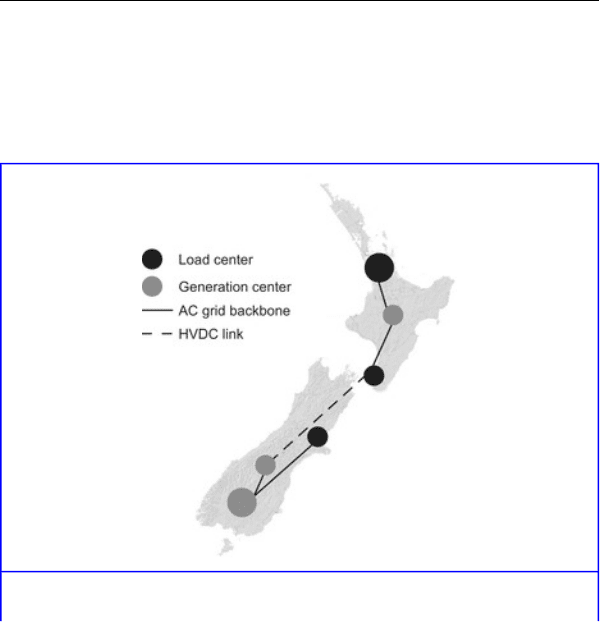Sioshansi F.P. Smart Grid: Integrating Renewable, Distributed & Efficient Energy
Подождите немного. Документ загружается.


Dispatch of DR with a Scalpel Rather than a
Sledgehammer
Stakeholder discussion in the Shortage Pricing Working
Group, Load Management experience from the summer of
2010, as well as stakeholder discussions about the
relationship between reliability and limitations on the
performance requirements of Load Management, have
resulted in a new stakeholder effort to reconsider the
granularity of DR dispatch. The Shortage Pricing proposal
filed by PJM included a requirement that CSPs keep PJM
informed of MW of Load Management not already reduced in
response to market prices and therefore, available to be
deployed in response to shortage prices or an Emergency
Event. This requirement imposes more sophisticated asset
management and reporting obligations on CSPs.
38
38
PJM Interconnection, L.L.C., Initial Filing, Docket No. ER09-1063-006
(June 18, 2010).
PJM called for Load Management resources six times during
the 2010 summer, but in three of these events only the
resources in part of one transmission zone were needed.
Deploying all of the Load Management in the zone can in
some cases exacerbate rather than ameliorate the system
condition causing an Emergency Event. The impact of a load
reduction downstream of an overloaded transmission line, for
example will ameliorate the overload, while the impact of a
load reduction upstream may have no salutary effect or
worsen the overload.
861
Load Management experience before the 2010 summer
usually called for DR in one or more transmission zones.
Compliance has also been measured on a transmission zone
basis, meaning that the overall performance of the CSP's Load
Management portfolio in each transmission zone determines
compliance. Finally, the transmission zone is the most
granular information about the location of the Load
Management that the registration process currently captures.
The stakeholders believe that the newly formed Demand
Response Dispatch Senior Task Force should re-examine and
rethink Load Management capabilities and develop
requirements for sub-zonal dispatch.
CSPs participating in the recent expansion of Load
Management performance requirements to include not only
Limited Demand Response, but also Extended Summer
Demand Response and Annual Demand Response, also
considered the impact of automation and portfolios of varied
load reduction capability on the ability to deploy more
precisely, more granularly, and in a shorter time frame than
one or two hours.
The intersection of PJM's operational needs and the
capabilities of the DR will continue to evolve. Smart grid
investments begun by the infusion of stimulus funds,
however, will likely transform the dispatch capability of DR
over the next few years.
39
This enhanced capability will aid
DR in reaping the available rewards from participation in
PJM's markets while also aiding PJM in enhancing the
reliability of market and system operations and of the
efficiency of PJM's markets.
39
American Recovery and Reinvestment Act of 2009.
862
863

Chapter 18. Perfect Partners
Wind Power and Electric Vehicles – A New Zealand
Case Study
Magnus Hindsberger, John Boys and Graeme Ancell
Chapter Outline
Introduction 453
Wind Generation and Electric Vehicles in New Zealand
455
New Zealand Power System 455
New Zealand Electricity Market 456
Integration of Large-Scale Wind Generation in New
Zealand 457
Integration of Large Numbers of EVs in New Zealand
458
The Opportunity at Hand 460
Integration Costs of Wind and Electric Vehicles in New
Zealand 461
Assumptions 461
Modeling 462
864
Interaction Between Wind Generation and EV
Recharging 463
System Costs Impact 464
Cost of Recharging 466
Time of Recharge 467
Improving System Reliability by Plugged-In EVs 468
Frequency Fluctuations in New Zealand 469
Using DDC for Frequency Control 470
DDC Development Trends 472
Economics of DDC 474
Conclusions 476
Acknowledgments 476
References 476
This chapter uses a New Zealand case study to illustrate how wind power and electric vehicles can
work together to manage integration costs into the New Zealand power system, a rather smallish and
isolated network posing unique challenges The New Zealand system exhibits behavior not seen in
larger, interconnected networks, which makes large-scale wind generation and large numbers of electric
vehicles complementary when enabled by a smart grid, supporting rather than challenging the operation
of the power system The chapter's main contribution is to show how market integration costs can be
lowered and investment in generation, transmission, and distribution deferred through linking the
charging of electric vehicles to system frequency as well as price signals
Electric vehicles, wind energy storage, New Zealand
Introduction
The amount of installed capacity of wind generation around
the world is increasing rapidly. The best way of integrating
large-scale wind generation into power systems is being
considered by regulators, system operators, and transmission
owners. Wind generation output is intermittent in nature in
865
contrast to conventional power plants such as thermal or
hydro that could be scheduled when the power was needed.
1
1
The integration issues are discussed in more detail in Chapter 10.
Electric vehicles (EVs) have received less attention to date
but may provide a similar challenge in integration. Promotion
of EVs includes government subsidies to make them (more)
affordable and incentives such as offering free recharge while
shopping in the supermarket and rollout of quick charging
stations
2
that offer recharging almost as fast as refueling a
traditional car. While the latter two initiatives may increase
the uptake of EVs, they also promote charging from a
convenience point of view, potentially increasing the peak
demand for electricity. Increasing peak demand will be costly,
as it requires extra capacity in generation, transmission, and
distribution networks.
2
As per May 12, 2011, the CHAdeMO organization reported that 747 of
its quick-charge stations had been established worldwide, of which 656
are located in Japan, 87 in Europe, and 4 in the rest of the world (see
www.chademo.com).
So why are countries worldwide pursuing wind and EVs?
This is because wind power and EVs are two key factors in
reducing carbon emissions and the dependency on fossil
fuels. Both of these are also key objectives of the New
Zealand Energy Strategy [1].
New Zealand has great wind resources, and most new
generation commissioned is expected to be wind and
geothermal generation. The integration of large-scale wind
generation poses challenges, even more so where the grid is
part of a small island power system such as New Zealand.
866
The integration issues can be managed but the costs of
integration can be high.
The uptake of EVs in New Zealand is less certain. There are
good benefits from a carbon emission reduction perspective
as EVs can be supplied with electricity from largely
renewable sources. However, should large numbers of EVs be
introduced in New Zealand, high integration costs could be
the result as investments in generation, transmission, and
distribution need to be brought forward, if EV owners
recharge when they want rather than when there is spare
capacity in the system.
This chapter will show how getting the right price signals for
charging EVs and the use of dynamic demand control (DDC)
can considerably reduce the integration costs of both
large-scale wind generation and a high uptake of EVs in New
Zealand. Their use also provides the opportunity to reduce the
magnitude of the perennial problem of large frequency
fluctuations on island power systems. While the latter issue
may be specific to New Zealand and some other islanded
systems, the remainder of the findings should be applicable
for most other markets, where wind and EVs are seen as key
parts of a future, low-carbon energy system.
This chapter is organized into four sections. The section
“Wind Generation and Electric Vehicles in New Zealand”
starts by providing a brief overview of the New Zealand
power system, its electricity market, and integration issues for
wind generation and EVs in New Zealand. The section “The
Opportunity at Hand” outlines the opportunity to reduce
power system operating costs through the use of price and
reliability signals. The section “Integration Costs of Wind and
Electric Vehicles in New Zealand” describes the results of a
867

study on reducing the integration costs of large numbers of
EVs based on price signals. The section “Improving System
Reliability by Plugged-In EVs” introduces dynamic demand
control and how it can help to increase reliability in systems
with a high penetration of wind power, followed by the
chapter's main conclusions.
Wind Generation and Electric Vehicles in New
Zealand
New Zealand Power System
The New Zealand power system (Figure 18.1) is made up of
two AC island power systems connected by an HVDC bipole
link. Given its remote location, New Zealand has no
interconnection to other power systems.
Figure 18.1
868

New Zealand power system.
Source: Transpower [2]
The system has a peak demand of around 6,600 MW. The
North Island demand ranges between 1,600 and 4,600 MW.
The South Island demand ranges between 1,100 and 2,200
MW. The HVDC bipole linking the South Island and the
North Island power systems has a current capacity of 700
MW. This capacity will increase to 1,200 MW in 2013.
Generation is largely renewable and generally located far
from the load centers, making transmission an important
consideration. Table 18.1 shows a breakdown of the installed
capacity and how much energy was generated by each source
in 2009. As seen, renewable generation such as hydro,
geothermal, and wind makes up about 70% of total
generation. Coal generation has been declining in recent
years, being replaced by generation from geothermal, gas, and
wind.
Table 18.1
Grid-Connected Generation in New Zealand
Fuel Type
Installed
Capacity Dec
2009 (MW)
Installed
Capacity Dec
2009 (%)
Electricity
Generated in
2009 (GWh)
Electricity
Generated in
2009 (%)
Hydro 5,378 57% 23,962 57%
Geothermal 635 7% 4,542 11%
Wind 496 5% 1,456 3%
Gas 1,747 18% 8,385 20%
Coal 949 10% 3,079 7%
Oil 156 2% 8 0%
Other 125 1% 578 1%
Total 9,486 100% 42,010 100%
Source: MED [3].
869

New Zealand already generates approximately 70% of its
annual electricity from renewable sources, among the highest
globally. The New Zealand Energy Strategy to 2050
published in 2007 set a target for 90% of electricity generated
from renewable sources by 2025 [1].
3
The additional
renewable generation will likely be predominantly from wind
and geothermal energy sources.
3
The 2007 New Zealand Energy Strategy is due to be replaced with a new
strategy in 2011. It is expected that the new strategy will maintain the
90% renewable electricity generation target, though with the caveat that
only if it does not compromise security of supply.
New Zealand Electricity Market
The New Zealand Electricity Market is a wholesale market
that includes offer-based merit order dispatch using locational
marginal pricing to determine the lowest cost secure dispatch
solution overall (see NZIER [4]).
Nodal pricing takes into account the impacts of both losses
and congestion on delivering electricity to a particular point
in the power system. Furthermore, the price includes the costs
of spinning reserves, as the market model co-optimizes the
dispatch of energy and instantaneous reserves.
Generator offers can be submitted up to 36 hours in advance
of physical delivery and can be changed at any time until 2
hours before delivery. Generation dispatch occurs every five
minutes based on the offers received. Pricing is based on
half-hour averages of the prices resulting from dispatch in
each five-minute block.
870
